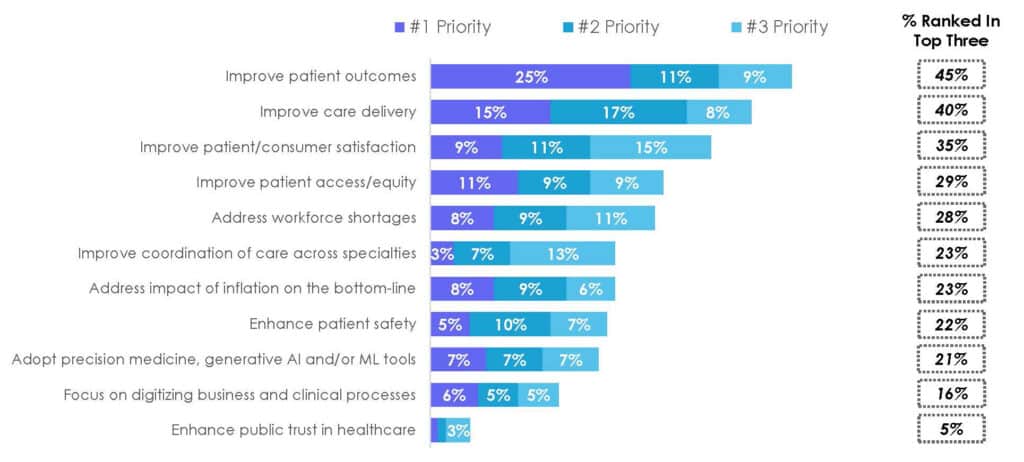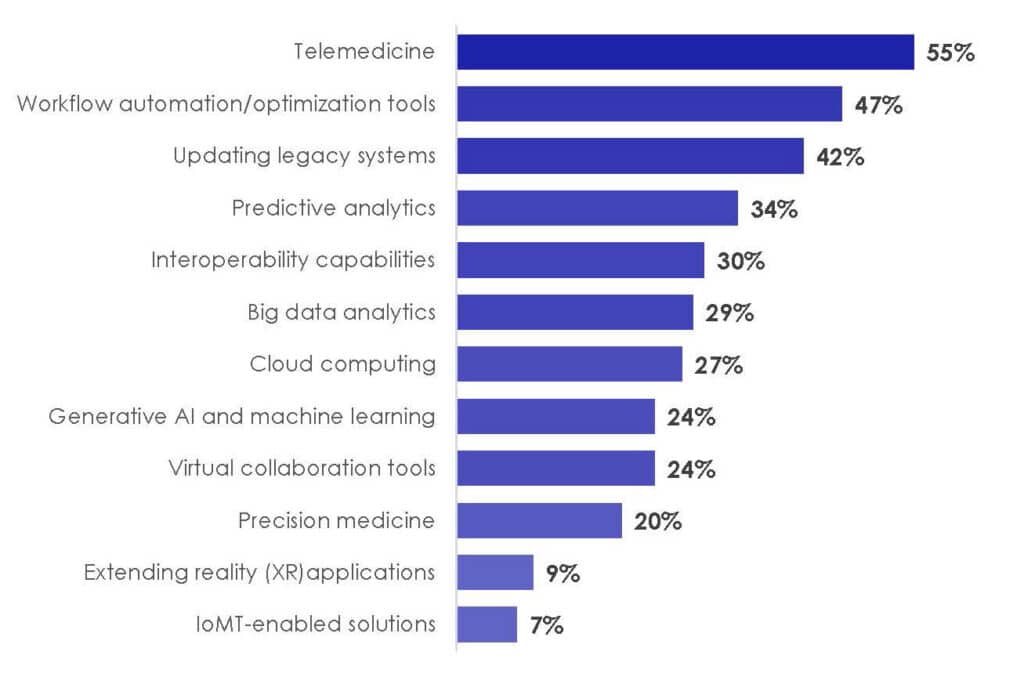Thought Leadership
Prioritizing Health Tech Investments: Key Considerations for Leaders

Considering the broad spectrum of priorities that healthcare organizations must juggle today, the wide range of technologies available to address those multi-faceted needs, and the mountain range of obstacles that can hinder digital transformation, how exactly can health leaders achieve the biggest bang for their tech budget?
Research conducted by HIMSS Market Insights aimed to answer this dilemma by unraveling the perspectives and priorities of healthcare leaders at hospitals, clinics, academic medical centers and healthcare systems of all sizes. The survey, “Targeting the Biggest Bang for the Buck,” asked executives, IT directors and clinical leaders about the impact of technological investments to meet organizational goals.
In this final installment of our three-part blog series, we’ll dig into the survey results to finally answer this burning question and point leaders toward the most impactful tech investment in healthcare.
Keeping the focus on patient care
Not surprisingly—and somewhat reassuringly—healthcare organizations are prioritizing initiatives that improve patient outcomes (45%), care delivery (40%), patient satisfaction (35%) and access to equitable care (29%). Despite the financial, regulatory and technological burdens they must balance to sustain operations, patient-centered care remains the driving force in healthcare decision-making.

Over the last year or two, at least 3 in 5 organizations have invested in technologies that successfully improved patient outcomes (64%), enhanced patient safety (62%) and strengthened care delivery (61%).
But which technologies are organizations actually using to drive these results? Specifically, the most impactful technologies for achieving these goals include:

But in a space as complex as healthcare, none of these tools offer a one-size-fits-all solution. As we’ve previously pointed out, the best tech solution for your organization might depend on several factors, including:
- Patient demographics: Organizations serving rural or underserved populations might prioritize telehealth and remote monitoring solutions to improve access to care.
- Financial constraints: Organizations facing tight budgets might prioritize economical solutions with rapid ROI, such as cloud-based tools that reduce IT costs.
- Strategic goals: If the main objective is to enhance care coordination across the network, organizations might prioritize interoperability solutions or virtual collaboration tools.
- Existing infrastructure: Organizations with outdated systems need to update legacy systems by migrating to the cloud or implementing an EHR before pursuing more advanced initiatives.
These factors, combined with changing regulatory requirements, workforce skills and availability, and other organizational needs, all intersect to determine each company’s path toward digital transformation.
The best solution for small organizations
For a small healthcare organization with limited resources, deciding where to invest your tech budget to make the most progress toward your strategic initiatives can be challenging. So, let me offer some advice: Look to the cloud.
While my advice is certainly not meant to replace the extensive due diligence your team must navigate before executing any technology initiative, I believe cloud solutions are foundational to digital transformation. The cloud offers several key advantages, especially for resource-strapped healthcare organizations:
- Reduced upfront costs: Cloud solutions eliminate the need for significant capital expenditures related to technology infrastructure and hardware. This enables organizations to shift from a CapEx to an OpEx model, paying only for the resources they actually use.
- Scalability and flexibility: Cloud platforms can easily scale to accommodate growth or changing needs. This is critically important for smaller organizations that may experience fluctuations in patient volume, enabling them to quickly adapt to new technologies and demands.
- Improved accessibility: Cloud-based systems give providers access to data and applications from any setting with an internet connection—facilitating remote work, telemedicine and collaboration between distributed teams and partners.
- Enhanced security: Reputable cloud providers invest heavily in security measures and often provide robust tools and services to help healthcare organizations meet regulatory requirements such as HIPAA.
- Faster deployment: Cloud platforms typically offer pre-built services and tools that can accelerate deployment, allowing smaller organizations to quickly adopt innovations like telehealth, AI and data analytics without extensive development efforts.
Given these advantages, it’s no wonder why cloud computing has been more frequently deployed than most other technologies, according to HIMSS research—second only to telemedicine, which likely runs on cloud solutions, too.
A balanced approach to digital transformation
That said, there’s rarely a single silver bullet solution to addressing healthcare’s multi-faceted demands, as this survey clearly showed. Digital transformation requires a balanced approach, integrating various technologies that solve different needs for each organization.
Ultimately, health leaders need to evaluate potential tech initiatives based on factors such as:
- ROI
- Impact on patient care
- Alignment with strategic goals
- Feasibility
- Risk
Of these, the most critical step is aligning IT investments with the organization’s overarching strategic goals. The quest to adopt the latest, greatest technologies should never cloud a healthcare organization’s focus on what matters most: improving patient care as sustainably, efficiently and cost-effectively as possible. Prioritizing technology solutions that can achieve all of these objectives simultaneously is the key to achieving the biggest bang for the buck.
Catch up on the blog series:
Part 1: Striking Alignment Around Health Tech Investments
Part 2: Overcoming Financial Barriers to Digital Transformation































